Pecharsky V.K., Zavalij P.Y. Fundamentals of Powder Diffraction and Structural Characterization of Materials
Подождите немного. Документ загружается.


Chapter
5
Sample
:
LaNi,.
&no.
,,
20.288
22.105
...
81.632
CHOICE=3,
WAVE=1.540593,
END
*
0.000
!
Title line
!
Bragg angle of the first observed peak
!
Bragg angle of the second observed peak
!
Bragg angles in ascending order
!
Bragg angle of the last observed peak
!
Blank line terminating experimental data
!
Instruction specifying input as 20 angles
!
Instruction specifying the wavelength
!
End of instructions
!
The value of the zero shift, if known
In
our first indexing attempt we will use all observed Bragg peaks,
including the two peaks from an impurity phase at 20
=
44.21 1" and 5 1.5 17"
(see
Figure
5.9, without correcting experimental data for the known zero
shift error. Automatic indexing results in the following solution:
a
=
18.537,
c
=
4.368 1
A
in the hexagonal crystal system with
F24
=
16(O.OO8, 205) and
M20
=
21. One weak Bragg peak at 20
=
78.958" (relative intensity is 0.4%)
remains unindexed. This solution is likely incorrect, which is easily
concluded from the
FN
figure of merit indicating that only -12% of the
possible Bragg peaks have been observed.
After removing the two impurity Bragg peaks (data file
Ch5Ex04-Treor90-Clean.dat,
found on the CD), the indexing result is
a
=
6.179,
c
=
10.097
A
in the tetragonal crystal system with
Fz2
=
12(0.019, 98)
and
M20
=
16. Both figures of merit are lower than in the first solution, and
this is also an incorrect indexing result.
Even though it appears that this program cannot find an indexing solution
in this relatively simple case, we should note that so far the program was
used only with default settings, including the minimum acceptable figure of
merit. The default value is set at
Mzo
=
10, and once the solution with
Mzo
exceeding 10 is found, no further attempt to test lattices with lower (i.e. next
in the line: cubic, tetragonal, hexagonal, orthorhombic, monoclinic and
triclinic) symmetry is made. This is the reason of the incorrect solution when
all but the two impurity peaks were included in the data file
Ch5Ex04-Treor90-Clean.dat.
A simple modification of the default figure of merit by including the
instruction MERIT=40, which is nearly double the best
Mzo
observed so far
(data file
Ch5Ex04-Treor90-HighMerit.dat
is found on the CD) yields a
correct solution: hexagonal lattice with
a
=
5.0443,
c
=
4.0135
A
and the
corresponding figures of merit are as follows:
F22
=
126 (0.008, 23) and
M20
=
189. The lattice parameters and figures of merit are slightly different from
what has been established earlier (see
Table
5.6 and associated text), which
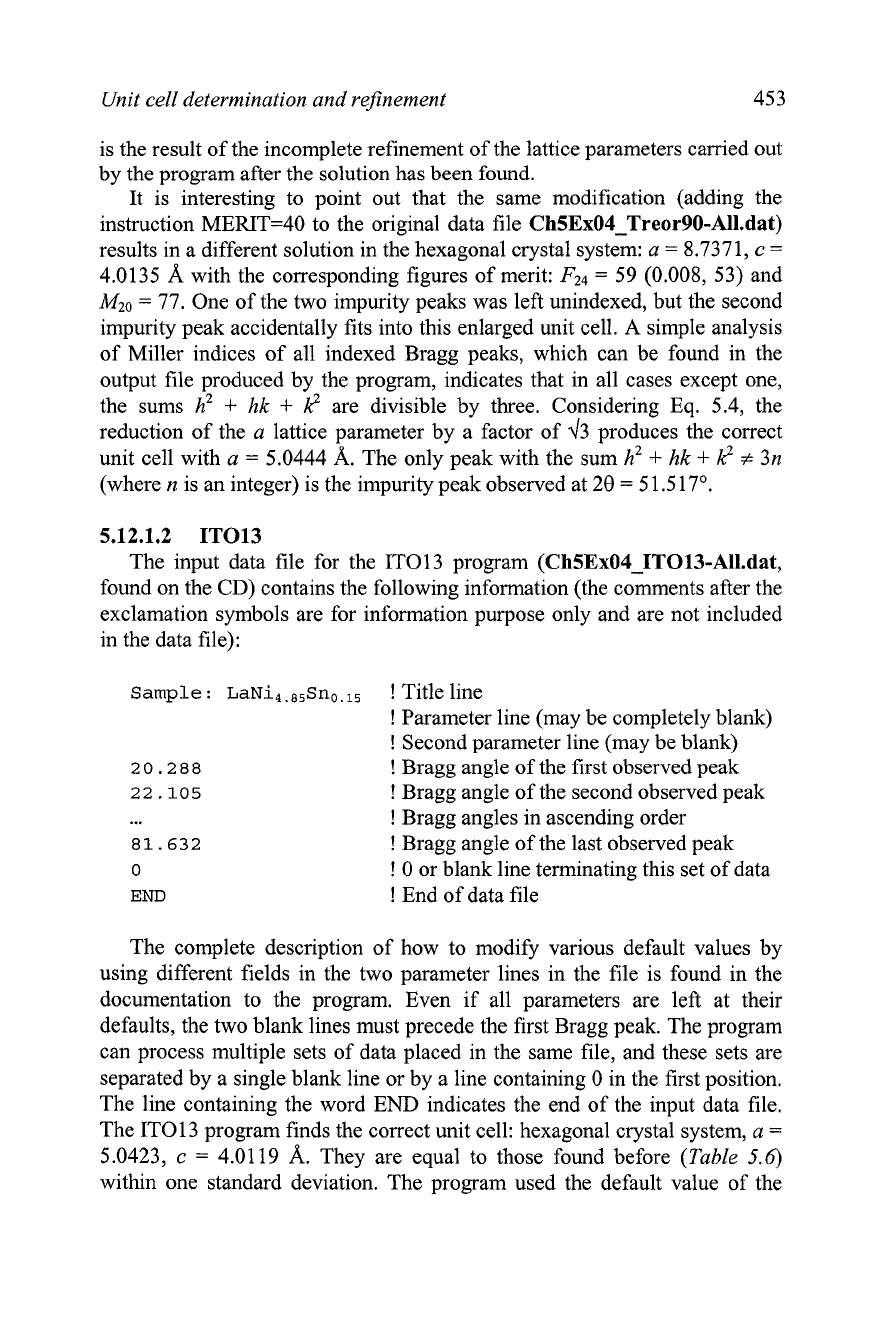
Unit cell determination and rejkement
453
is the result of the incomplete refinement of the lattice parameters carried out
by the program after the solution has been found.
It is interesting to point out that the same modification (adding the
instruction MERIT=4O to the original data file
Ch5Ex04-Treor90-All.dat)
results in a different solution in the hexagonal crystal system:
a
=
8.7371,
c
=
4.0135
A
with the corresponding figures of merit:
F24
=
59 (0.008, 53) and
M20
=
77. One of the two impurity peaks was left unindexed, but the second
impurity peak accidentally fits into this enlarged unit cell.
A
simple analysis
of Miller indices of all indexed Bragg peaks, which can be found in the
output file produced by the program, indicates that in all cases except one,
the sums
h2
+
hk
+
h?
are divisible by three. Considering Eq. 5.4, the
reduction of the
a
lattice parameter by a factor of 43 produces the correct
unit cell with
a
=
5.0444
A.
The only peak with the sum
h2
+
hk
+
h?
#
3n
(where
n
is an integer) is the impurity peak observed at 20
=
5 1.5 17".
5.12.1.2 IT013
The input data file for the IT013 program (Ch5Ex04-IT013-All.dat,
found on the
CD)
contains the following information (the comments after the
exclamation symbols are for information purpose only and are not included
in the data file):
Sample
:
LaNi,
.
,,Sn,.
,,
!
Title line
!
Parameter line (may be completely blank)
!
Second parameter line (may be blank)
20.288
!
Bragg angle of the first observed peak
22.105
!
Bragg angle of the second observed peak
...
!
Bragg angles in ascending order
81.632
!
Bragg angle of the last observed peak
o
!
0 or blank line terminating this set of data
END
!
End of data file
The complete description of how to modify various default values by
using different fields in the two parameter lines in the file is found in the
documentation to the program. Even if all parameters are left at their
defaults, the two blank lines must precede the first Bragg peak. The program
can process multiple sets of data placed in the same file, and these sets are
separated by a single blank line or by a line containing
0 in the first position.
The line containing the word END indicates the end of the input data file.
The IT01 3 program finds the correct unit cell: hexagonal crystal system,
a
=
5.0423,
c
=
4.01 19
A.
They are equal to those found before
(Table
5.6)
within one standard deviation. The program used the default value of the
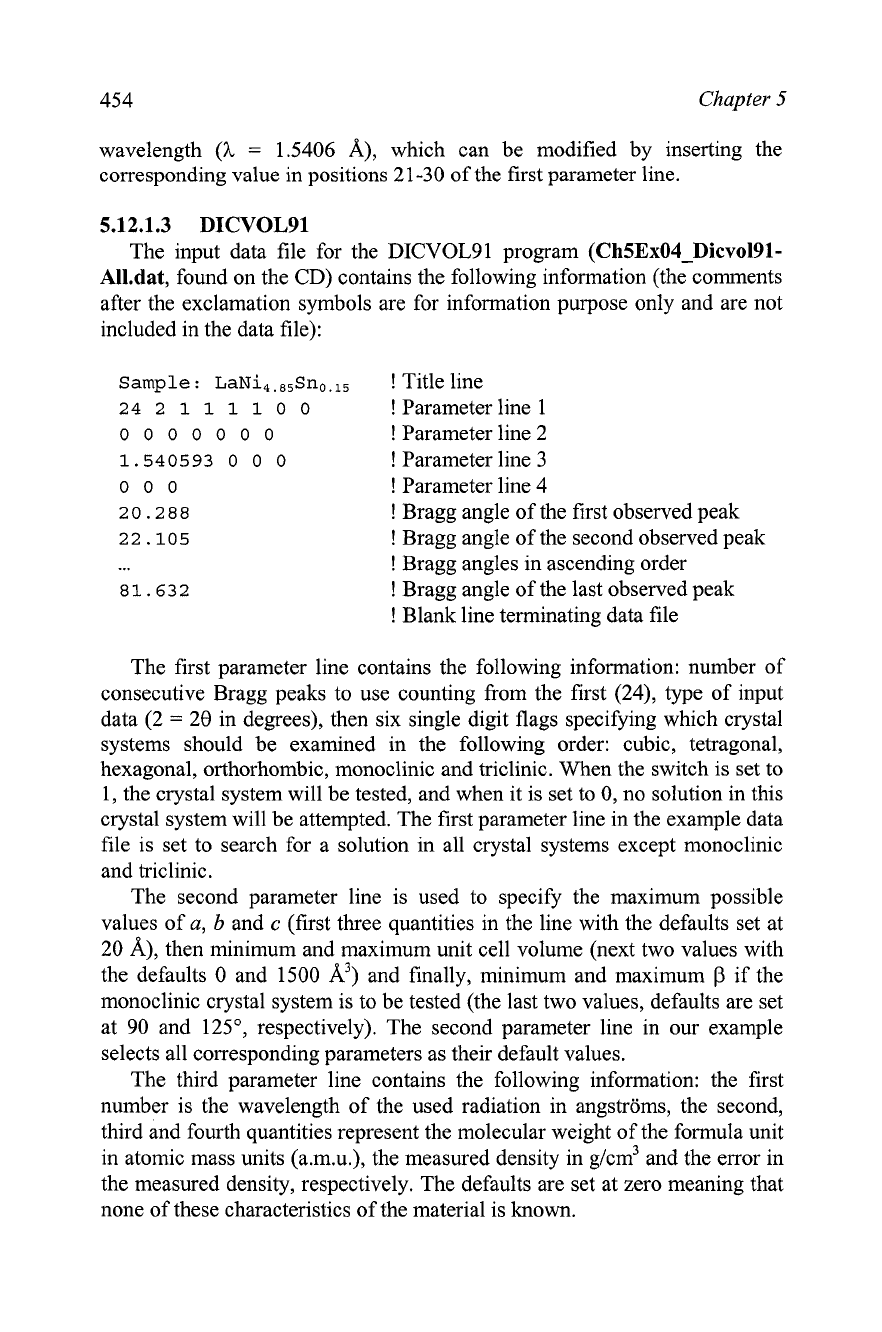
454 Chapter
5
wavelength
(h
=
1.5406 A), which can be modified by inserting the
corresponding value in positions
21-30
of the first parameter line.
5.12.1.3 DICVOL91
The input data file for the DICVOL91 program (ChSEx04-Dicvol91-
All.dat, found on the CD) contains the following information (the comments
after the exclamation symbols are for information purpose only and are not
included in the data file):
Sample
:
LaNi,
.
,,Sn,.
,,
!
Title line
242111100
!
Parameter line 1
ooooooo
!
Parameter line
2
1.540593
o o
o
!
Parameter line
3
000
!
Parameter line 4
20.288
!
Bragg angle of the first observed peak
22.105
!
Bragg angle of the second observed peak
...
!
Bragg angles in ascending order
81.632
!
Bragg angle of the last observed peak
!
Blank line terminating data file
The first parameter line contains the following information: number of
consecutive Bragg peaks to use counting from the first (24), type of input
data
(2
=
28 in degrees), then six single digit flags specifying which crystal
systems should be examined in the following order: cubic, tetragonal,
hexagonal, orthorhombic, monoclinic and triclinic. When the switch is set to
1, the crystal system will be tested, and when it is set to 0, no solution in this
crystal system will be attempted. The first parameter line in the example data
file is set to search for a solution in all crystal systems except monoclinic
and triclinic.
The second parameter line is used to specify the maximum possible
values of a,
b
and
c
(first three quantities in the line with the defaults set at
20 A), then minimum and maximum unit cell volume (next two values with
the defaults
0 and 1500 A3) and finally, minimum and maximum
P
if the
monoclinic crystal system is to be tested (the last two values, defaults are set
at 90 and
125", respectively). The second parameter line in our example
selects all corresponding parameters as their default values.
The third parameter line contains the following information: the first
number is the wavelength of the used radiation in angstroms, the second,
third and fourth quantities represent the molecular weight of the formula unit
in atomic mass units
(a.m.u.), the measured density in g/cm3 and the error in
the measured density, respectively. The defaults are set at zero meaning that
none of these characteristics of the material is known.
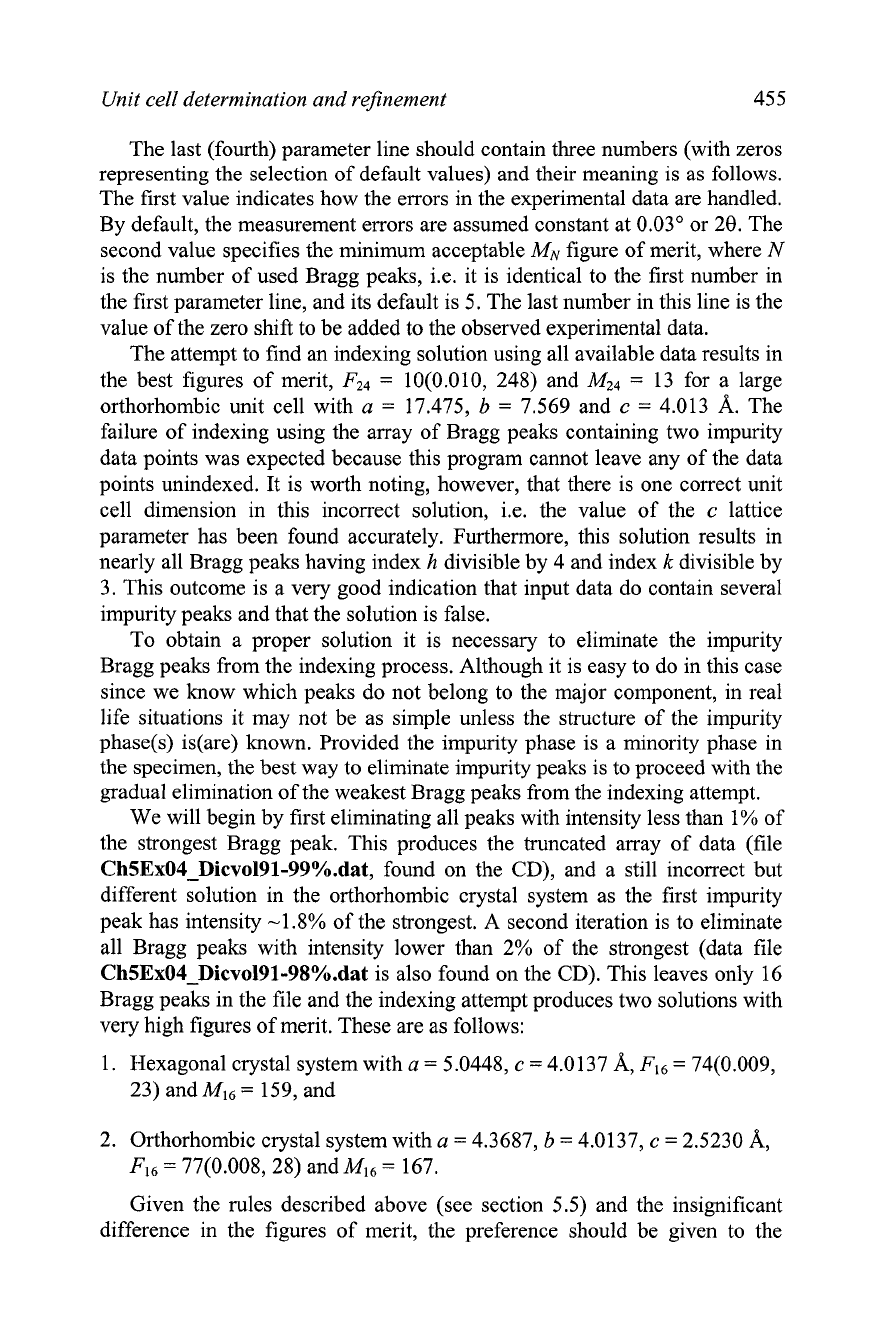
Unit cell determination and rejkement
455
The last (fourth) parameter line should contain three numbers (with zeros
representing the selection of default values) and their meaning is as follows.
The first value indicates how the errors in the experimental data are handled.
By default, the measurement errors are assumed constant at 0.03' or 28. The
second value specifies the minimum acceptable
MN
figure of merit, where
N
is the number of used Bragg peaks, i.e. it is identical to the first number in
the first parameter line, and its default is 5. The last number in this line is the
value of the zero shift to be added to the observed experimental data.
The attempt to find an indexing solution using all available data results in
the best figures of merit,
F24
=
lO(0.010, 248) and
M24
=
13 for a large
orthorhombic unit cell with
a
=
17.475,
b
=
7.569 and
c
=
4.013 A. The
failure of indexing using the array of Bragg peaks containing two impurity
data points was expected because this program cannot leave any of the data
points unindexed. It is worth noting, however, that there is one correct unit
cell dimension in this incorrect solution,
i.e. the value of the
c
lattice
parameter has been found accurately. Furthermore, this solution results in
nearly all Bragg peaks having index
h
divisible by 4 and index
k
divisible by
3.
This outcome is
a
very good indication that input data do contain several
impurity peaks and that the solution is false.
To obtain a proper solution it is necessary to eliminate the impurity
Bragg peaks from the indexing process. Although it is easy to do in this case
since we know which peaks do not belong to the major component, in real
life situations it may not be as simple unless the structure of the impurity
phase(s) is(are) known. Provided the impurity phase is a minority phase in
the specimen, the best way to eliminate impurity peaks is to proceed with the
gradual elimination of the weakest Bragg peaks from the indexing attempt.
We will begin by first eliminating all peaks with intensity less than
1%
of
the strongest Bragg peak. This produces the truncated array of data (file
Ch5Ex04-Dicvo191-99%.dat,
found on the CD), and a still incorrect but
different solution in the orthorhombic crystal system as the first impurity
peak has intensity -1.8% of the strongest. A second iteration is to eliminate
all Bragg peaks with intensity lower than 2% of the strongest (data file
Ch5Ex04-Dicvo191-98%.dat is also found on the CD). This leaves only 16
Bragg peaks in the file and the indexing attempt produces two solutions with
very high figures of merit. These are as follows:
1. Hexagonal crystal system with
a
=
5.0448,
c
=
4.0137 A,
FI6
=
74(0.009,
23) and
MI6
=
159, and
2. Orthorhombic crystal system with
a
=
4.3687,
b
=
4.0137,
c
=
2.5230 A,
F16
=
77(0.008,28) and
MI6
=
167.
Given the rules described above (see section 5.5) and the insignificant
difference in the figures of merit, the preference should be given to the

456 Chapter
5
highest symmetry crystal system, i.e. to the solution No. 1, even if we did not
know the correct lattice parameters of this material. Furthermore, the value
of the lattice parameter c in the orthorhombic solution is too small
considering the size of one of the components in the LaNi4,85Sno,15
compound: r~~
=
1.87 A, which restricts the shortest unit cell dimension to
2xrLa
=
3.74
A
or higher.
The indexing process in this case should be finalized by using the found
lattice parameters to assign indices to the weak Bragg reflections that have
been eliminated
from the indexing and by refinement of the lattice
parameters employing all available experimental data. This can be easily
done following the procedure described earlier in section 5.4.
The two solutions (hexagonal and orthorhombic) are actually similar,
since any hexagonal lattice can also be described in the lower symmetry
orthorhombic base-centered lattice, as shown schematically in Figure
5.14.
Obviously, the orthorhombic solution, found by DICVOL9
1,
represents the
primitive orthorhombic unit cell with 114 the volume of the conforming
base-centered orthorhombic unit cell with the following unit cell dimensions:
a0
=
1/2aHd3; bo
=
CH, and co
=
1/2bH.
Figure
5.14.
The relationship between the lattice parameters of the hexagonal unit cell (solid
and dotted lines) and the related orthorhombic unit cell (dashed lines). The unit cell parameter
perpendicular to the plane of the projection is identical in both crystal systems. The smaller
orthorhombic unit cell found using the DICVOL91 indexing program is indicated by the thick
solid vectors
(aqo and cqo) Open circles show lattice points and the dash-dotted vector
illustrates the C-translation in the conforming orthorhombic lattice.

Unit cell determination and refinement
457
5.12.2
Monoclinic indexing: (CH3NH3)2M07022
In
this example, we consider the ab initio indexing of the diffraction
pattern collected from (CH3NH3)2M07022 powder. Profile fitting of the
powder diffraction data (Figure 5.15) resulted in 30 peaks observed below
30" of 28 (Table 5.21). The indexing has been conducted using TREOR,
DICVOL and ITO. Attempts to use TREOR produce no reasonable solution
in high symmetry crystal systems, including orthorhombic. Because of the
complexity of the pattern, the maximum unit cell volume was increased from
a default (1500) to 2500
A3
by adding the instruction VOL=2500.
10 15 20 25 30 35 40
Bragg angle,
20
(deg.)
Figure
5.15.
Powder diffraction pattern of (CH3NH3)2M07022 collected on a Scintag
XDS2000 diffractometer using Cu
Ka
radiation in a step scan mode with A20
=
0.02' and
counting time 30 sec. The square root of intensity is plotted as a function of Bragg angle for
clarity. The two sets of vertical bars illustrate the following: top
-
positions of the observed
Bragg peaks, bottom
-
the same calculated in the space group C2/c for the solution No.
1
from
Table
5.22.
The two weak Bragg peaks preceding the strongest peak at 20
E
9'
have
been excluded from the indexing because their presence yields unreasonably large unit cells.'
These peaks probably belong to an impurity phase. It is quite possible because the
(CH3NH3)2M07022 powder was prepared hydrothermally (see section
6.15),
which
sometimes results in the presence of several metastable phases in the material.

45
8
Chapter
5
Table
5.21.
Relative integrated intensities (Illo), Bragg angles (listed for the location of the
Ka, component in the doublet,
h
=
1
S40593
A)
and full widths at half maximum (FWHM) of
Bragg peaks observed in the range
7
5
28
I
30"
in the (CH3NH3)2M07022 powder diffraction
pattern collected using Cu
K,
radiation (see
Figure
5.15).
114,
20
(deg) FWHM (deg)
IIIo
20
(deg) FWHM (deg)
1000 9.077 0.089
10 24.033 0.077
10 9.574
0.089 109 24.343
0.077
34 10.716
0.085 110 25.162
0.080
17 15.328 0.084
257 25.321 0.080
8 16.653 0.084
68 25.394 0.080
6
17.496 0.084
98 25.896 0.080
10 18.264 0.084
16 26.758 0.081
18 1 8.449 0.084
8 27.016 0.081
4
19.240
0.084 3 8 27.581 0.081
17 20.030 0.084
1 27.771
0.081
4 21.130 0.081
11 28.093 0.081
15
2 1.466 0.081
1 28.600 0.081
89
21.614
0.081 45 29.069 0.081
1 23
A66
0.08 1 29 29.368 0.08 1
1 23.641 0.081 21 29.725 0.081
Keeping the maximum unit cell volume at 2500
A3,
indexing attempts
using TREOR were extended to include the monoclinic crystal system by
adding the instruction MONO=130 (data file Ch5Ex05Treor90.dat is
found on the CD). The program finds several solutions, and the one listed in
the first row in
Table
5.22
appears reasonable. Despite the relatively low
figure of merit
(MZ0
=
9)
it is promising because all Bragg peaks are indexed
in the base-centered lattice.
To confirm the feasibility of this monoclinic unit cell, indexing was
attempted using both DICVOL and ITO. The latter gives no acceptable
solution, while the former results in three unit cells. The best of the three is
listed in the second row in
Table
5.22.
All Bragg peaks can be indexed, but
this time in a body-centered lattice. The two remaining solutions correspond
to base-centered unit cells with all peaks indexed. They have slightly lower
figures of merit but the same unit cell volume and parameter
b.
As an
exercise use experimental data provided on the CD or in
Table
5.21
and run
DICVOL to see all unit cells.
The unit cell edges,
a
and
c,
and angle
P
in all three solutions are related
to one another as shown in
Figure
5.16.
Here, a, c and angle
P
correspond to
those in the first row in
Table
5.22.
The inverse of the body diagonal of the
parallelogram ac, d
=
-a
-
c, can be used as the third choice of the unit cell
edge giving a total of three possible selections of the unit cell: a and c,
a
and
d, and d and c. Since the first pair produces a base-centered lattice, then the
second combination remains base-centered, but the third unit cell should be
body-centered, which is not standard in the monoclinic crystal system. The

Unit cell determination and refinement
459
transformation to a standard setting
(a',
b'
and
c')
is shown in
Table
5.22
in
column
6
with the resulting unit cell dimensions shown in columns
7
and
8.
Table
5.22.
Indexing solutions describing powder diffraction data of (CH3NH3)2M07022.
Solution
a, b, c
p,
V
MN
Lattice
a',b',ct
a',bt,c'
p'
Source
number centering
1 20.624 109.93 920 C TREOR
5.525
19.592 2098.7
2 23.105 127.11 9.g3~ I
-a
23.105 122.95 DICVOL
5.524
b
5.524
20.626 2099.3
a+c
19.601
3 20.589 109.94 4020a C
a+2c
23.060 122.93
TREOR~
5.514
b
5.514
9.7790 1044.9
-2~
19.561
4 23.060 127.12 2o.s3~ I
-a
23.060 122.93
DICVOL~
5.514
b
5.514
20.590 2087.7
a+c
19.561
5C 20.564 109.92 lO.GzO C
a+c
23.043 122.97 ITO~
5.512
b
5.512
19.546 2082.9
-C
19.546
a
4 peaks unindexed; found volume is half that from other solutions.
20 corrected for a sample shift error, 8, as 2OCon
=
200bS
-
180/7~~28~~0~0lR (8
=
-0.1 mm;
goniometer radius
R
=
250
rnm).
Second best solution according to the figure of merit. The best FOM is 39.4 with half the
unit cell volume and only 17 of 20 reflections indexed; also see solution No.
3.
Figure
5.16.
Alternative axes selection in the monoclinic crystal system. Open and hatched
points represent lattice points. The open points are located in the plane, while the hatched
points are raised by 112 of the full translation in the direction perpendicular to the plane of the
projection. Unit cells based on the vectors
a
and
c
or
a
and
d
correspond to a base-centered
(C) lattice, while the unit cell based on the vectors
c
and
d
corresponds to a body-centered
lattice.
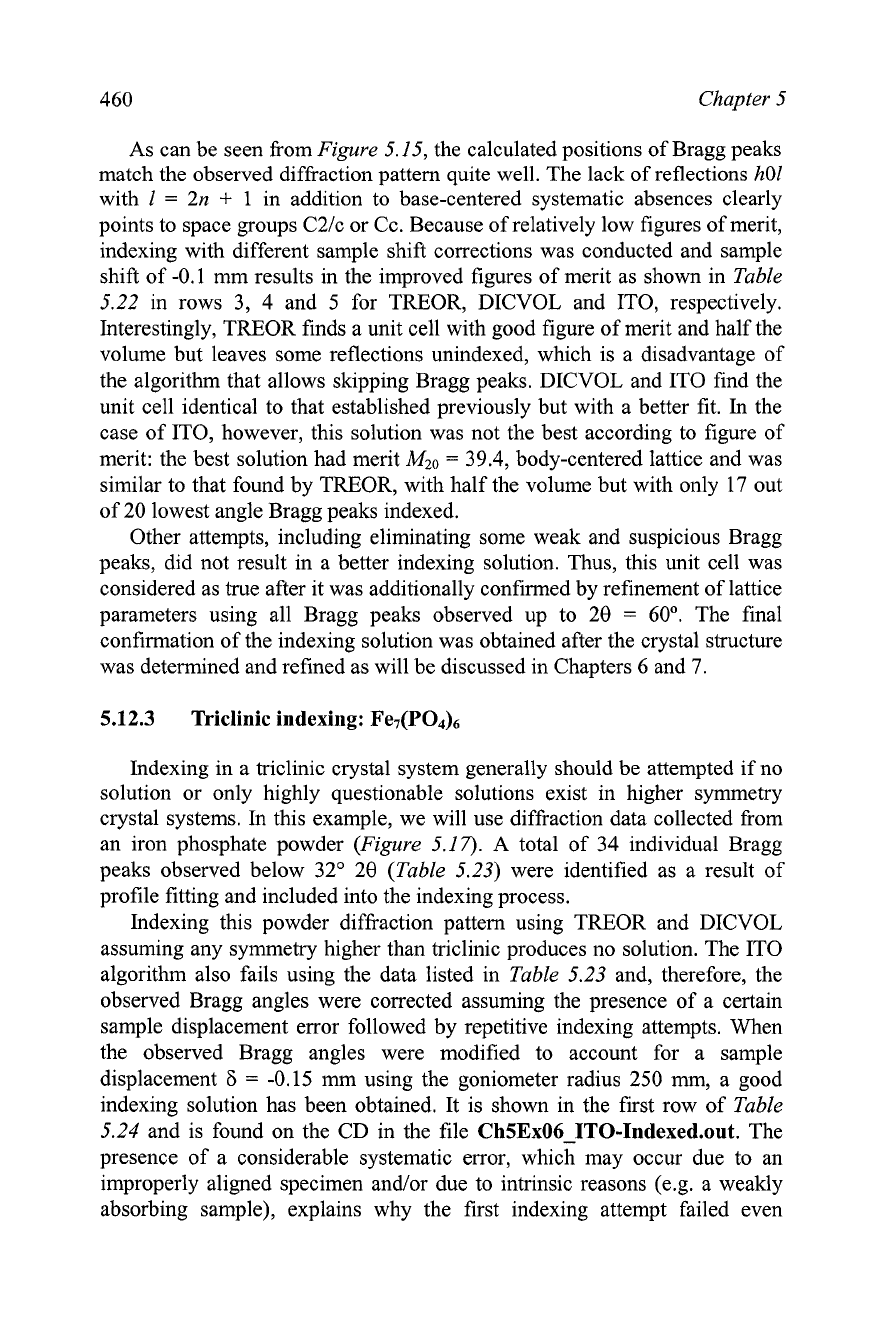
460 Chapter 5
As can be seen from Figure 5.15, the calculated positions of Bragg peaks
match the observed diffraction pattern quite well. The lack of reflections
h01
with 1
=
2n
+
1
in addition to base-centered systematic absences clearly
points to space groups C2/c or Cc. Because of relatively low figures of merit,
indexing with different sample shift corrections was conducted and sample
shift of -0.1 mm results in the improved figures of merit as shown in Table
5.22 in rows
3,
4 and 5 for TREOR, DICVOL and ITO, respectively.
Interestingly, TREOR finds a unit cell with good figure of merit and half the
volume but leaves some reflections unindexed, which is a disadvantage of
the algorithm that allows skipping Bragg peaks. DICVOL and
IT0 find the
unit cell identical to that established previously but with a better fit. In the
case of ITO, however, this solution was not the best according to figure of
merit: the best solution had merit
MZ0
=
39.4, body-centered lattice and was
similar to that found by TREOR, with half the volume but with only 17 out
of 20 lowest angle Bragg peaks indexed.
Other attempts, including eliminating some weak and suspicious Bragg
peaks, did not result in a better indexing solution. Thus, this unit cell was
considered as true after it was additionally confirmed by refinement of lattice
parameters using all Bragg peaks observed up to 28
=
60". The final
confirmation of the indexing solution was obtained after the crystal structure
was determined and refined as will be discussed in Chapters 6 and 7.
5.12.3 Triclinic indexing: Fe7(P0&
Indexing in a triclinic crystal system generally should be attempted if no
solution or only highly questionable solutions exist in higher symmetry
crystal systems. In this example, we will use diffraction data collected from
an iron phosphate powder (Figure 5.1
7).
A total of 34 individual Bragg
peaks observed below 32" 28 (Table 5.23) were identified as a result of
profile fitting and included into the indexing process.
Indexing this powder diffraction pattern using TREOR and DICVOL
assuming any symmetry higher than triclinic produces no solution. The
IT0
algorithm also fails using the data listed in Table 5.23 and, therefore, the
observed Bragg angles were corrected assuming the presence of a certain
sample displacement error followed by repetitive indexing attempts. When
the observed Bragg angles were modified to account for a sample
displacement
6
=
-0.15 mm using the goniometer radius 250
mm,
a good
indexing solution has been obtained. It is shown in the first row of Table
5.24 and is found on the CD in the file ChSEx06-ITO-1ndexed.out. The
presence of a considerable systematic error, which may occur due to an
improperly aligned specimen and/or due to intrinsic reasons
(e.g. a weakly
absorbing sample), explains why the first indexing attempt failed even
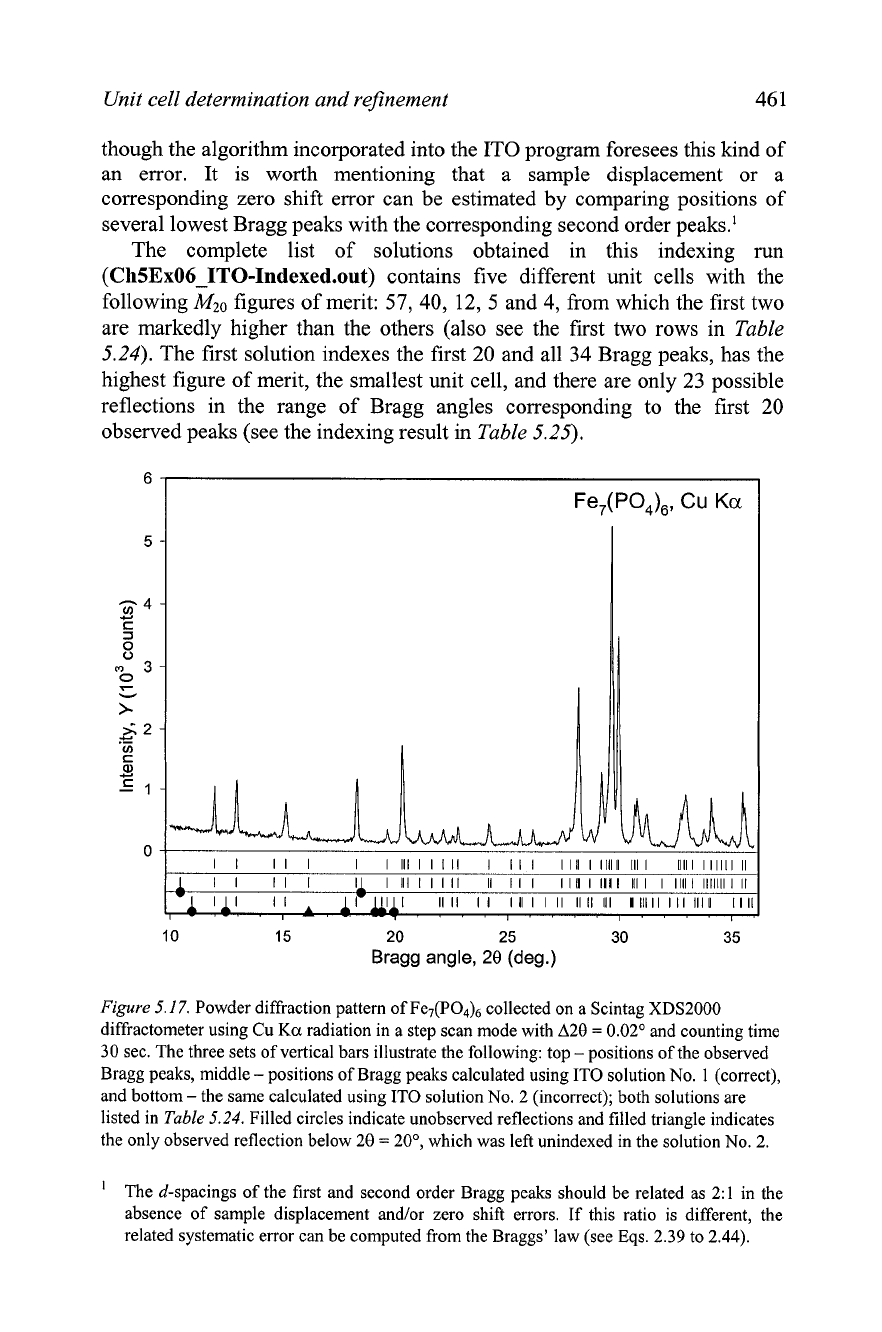
Unit cell determination and
refinement
46 1
though the algorithm incorporated into the IT0 program foresees this kind of
an error. It is worth mentioning that a sample displacement or a
corresponding zero shift error can be estimated by comparing positions of
several lowest Bragg peaks with the corresponding second order peaks.'
The complete list of solutions obtained in this indexing run
(Ch5Ex06-ITO-1ndexed.out)
contains five different unit cells with the
following
MZ0
figures of merit:
57,
40, 12,
5
and
4,
from which the first two
are markedly higher than the others (also see the first two rows in
Table
5.24).
The first solution indexes the first 20 and all 34 Bragg peaks, has the
highest figure of merit, the smallest unit cell, and there are only 23 possible
reflections in the range of Bragg angles corresponding to the first
observed peaks (see the indexing result in
Table
5.25).
Figure
5.17.
Powder diffraction pattern of Fe7(P0& collected on a Scintag XDS2000
diffractometer using Cu
Ka
radiation in a step scan mode with A20
=
0.02O and counting time
30
sec. The three sets of vertical bars illustrate the following: top -positions of the observed
Bragg peaks, middle
-
positions of Bragg peaks calculated using IT0 solution No.
1
(correct),
and bottom
-
the same calculated using IT0 solution No.
2
(incorrect); both solutions are
listed in
Table 5.24.
Filled circles indicate unobserved reflections and filled triangle indicates
the only observed reflection below
20
=
20•‹, which was left unindexed in the solution No.
2.
s2-
w
.-
V)
s
B
=I-
0
'
The d-spacings of the first and second order Bragg peaks should be related as 2:l in the
absence of sample displacement andlor zero shift errors. If this ratio is different, the
related systematic error can be computed from the Braggs' law (see Eqs.
2.39
to 2.44).
I
\nll
I I
II
I
I
11111IIIl
1111
1IIIII1l1111111 1111IIII11III
1
I I I
I
I
I1
1
111
1
1
1 11
11
11
1 1
I
II I
111
1
Ill
1
I
1111
I
1111111
I II
'1
111
II
A
17~1
1111
II
1111111
1111111
llllllllllllU Ill
1
-
.-.
.
I
,""I"",
10
15
20 25 30
35
Bragg angle,
29
(deg.)
